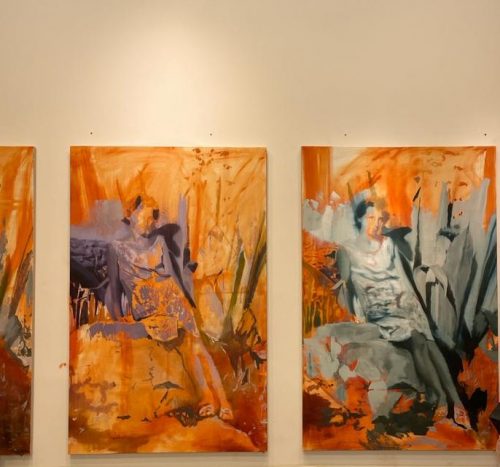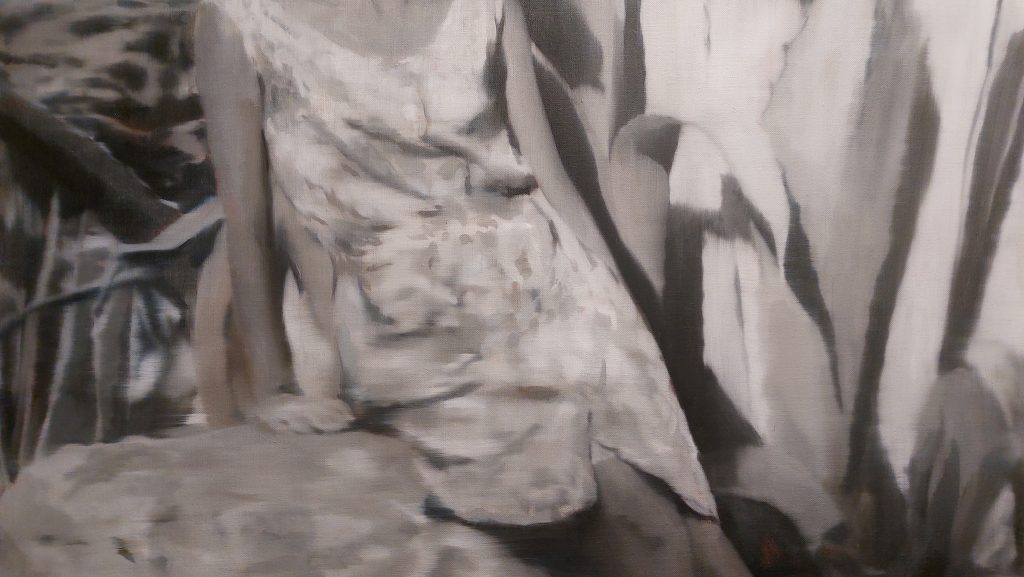
Opening event: 11:00 Thursday June 23rd, 2022
Gallery Talk with Artist Dan Orimian, Curator Michal Mor, and Dr. Naomi Habib: 12:30 Friday July 22nd, 2022
Dan Orimian – Sundowning
Early photos from a family photo album. On the timeline and editing table – photos from another place and time of a young girl with braids, alongside some few more photos of her as an adolescent who matured to become a beautiful and promising woman. Colorful Life in black and white.
On the opposite wall: Four paintings, four variations on her figure are drawn from reflection upon that single photograph dating to the 1960s, a pastoral image portraying her against a backdrop of a local rocky landscape. The photo illustrates an intersection of gazes – she is devoting herself to the camera, and her partner, the photographer, captures her image through the lens in her most beautiful moments.
In the last decade, my mother has rapidly declined following Alzheimer’s disease that struck her and caught us all unprepared. We watched her as she lost her identity. Moving away from us into a world of oblivion.
The act of painting seeks to deal with reality with interpretive tools. It’s within the action’s power to build a world of images and identities by layering material. A painting carries within it the traces of time: covering, blurring, deduction, concealing and building again. The final product is a necessity of accumulating all the moves that have taken place along the way. The painting contains all of these.
The painting remembers.
The motif of disappearance, erasure and repetition of the image is also repeated in a flickering film screened in the gallery, the result of a collaboration with video artist Neta Moses. In this film, a character is projected upon a painted canvas. The appearance of my grandfather’s character – my mother’s father – as I vaguely remember him from my childhood, similar to flickers of fragments of memory out of oblivion. It seeks to raise to the surface the lost memories and illuminate them, giving them renewed life for a mere moment.
Michal Mor, Curator
The blurring of the photographic image and the dissolution of reality into its primary and raw elements through stain, form and material, are used by Dan Orimian, the painter and son, as a tool to express the inconceivable gap between observing his mother’s present image and the gaping and inaccessible space left in her. The works bring together the perspectives of the artist, his mother and the viewers, capturing another perceptual gap described by the French psychoanalyst Jacques Lacan when distinguishing between sight and gaze: the emergence of the mother figure as perceived by the visual system undergoes the interpretive gaze of the son as returned to him through her blurred, unfocused, frightened eyes, which can no longer recognize her world. The works manage to illustrate the twilight stage in the transition between the symbolic and realistic dimension, between the social order and the chaos from which things came and to which all things return.
Orimian is influenced by the work of the German painter Gerhard Richter who painted based on photographs in the early 1960s, with a free brush, to the point that the autonomous texture prevailed over the realistic image. The blurring of the painting emphasizes the passage of time, the inability to rely on the perception of reality and the elusiveness of the image that purports to present truth but cannot grasp it. What appears reappears again only to disappear. Disappearence, repitition, erasing again, until the finished painting shows something else. The intention is not to create a reproduction or reconstruction but to try and capture the function of traces of time and their erasure.
Impressions by Dr. Naomi Habib
By mapping the brain at the cellular and molecular level, we reveal mechanisms behind the damage to the brain that leads to memory loss and cognitive impairment in Alzheimer’s disease. To do this we are using advanced technologies to track brain cells at a very high resolution and then combine these measurements with mathematical modeling.
Our journey with Dan started by talking about the microscopic level of cells in the brain and their loss and dysfunction in the diseased brain and ended in a discussion of the loss of the individual in front of our eyes due to the disease. Dan’s work helped us reconnect to the core of our motivation to study this devastating disease. With his brush he helped us see through his eyes the emotional burden of following the disappearance of a loved one. Personally, Dan’s work took me back to my own journey with my grandmother during her struggle with Alzheimer’s disease, seeing her being present and absent at the same time, maintaining her humor and her wit while losing her memories and parts of herself.
דמדומים – דן אורימיאן
תצלומים מוקדמים מתוך אלבום תמונות משפחתי. על ציר הזמן ושולחן העריכה – צילומים ממקום וזמן אחר של ילדה עם צמות. לצידם צילומים שלה כנערה שהבשילה ומספר צילומים שמתעדים אותה בבגרותה: אישה נאה ומבטיחה. חיים צבעוניים בשחור לבן.
על הקיר ממול: ארבעה ציורים, ארבע וריאציות על דמותה שמופיעה באחד הצילומים משנות השישים, דימוי פסטורלי המתעד אותה על רקע נוף טרשים מקומי. הצילום ממחיש הצטלבות מבטים – היא מתמסרת למצלמה, ובן זוגה, הצלם, מנציח אותה ברגעיה היפים מבעד לעדשה.
לפני כעשור התדרדרה אמי במהירות אל תוך מחלת האלצהיימר שהכתה בה ותפסה את כולנו לא מוכנים. צפינו בה מאבדת זהות. מתרחקת מאיתנו לעולם של שכחה.
פעולת הציור מבקשת להתמודד עם המציאות בכלים פרשניים, לבנות עולם של דימויים וזהויות בעזרת שכבות של חומר. ואכן ציור נושא בתוכו את עקבות הזמן: פעולות של כיסוי, טשטוש, גריעה, הסתרה ושוב בנייה. התוצר הסופי הוא הכרח של הצטברות כל המהלכים והשיבושים שהתרחשו בדרך. הציור מכיל בתוכו את כל אלה. הציור זוכר.
מוטיב ההיעלמות, מחיקתו וחזרתו של הדימוי, שב גם בסרט מרצד המוקרן בגלריה, פרי שיתוף פעולה עם אמנית הווידאו נטע מוזס. בסרט זה מופיעה דמות המוקרנת על בד קנווס מצויר. הופעת דמותו של סבי – אביו של אמי – כפי שהוא זכור לי מילדותי במעומעם, כמו בהבלחות של רסיסי זיכרון מתוך השכחה, מבקשת לדלות את הזיכרונות האבודים ולהאיר אותם, להעניק להם חיים מחודשים.
מיכל מור, אוצרת
טשטוש הדימוי הצילומי ופירוק המציאות למרכיביה הראשוניים והגולמיים באמצעות כתם, צורה וחומר, משמשים בידי דן אורימיאן, הצייר והבן, ככלי להבעת הפער הבלתי נתפס בין התבוננות בדמותה הנוכחת של אמו לבין החלל הריק והבלתי נגיש שנפער בה. היצירות מפגישות בין נקודות מבטם של האמן, של אמו ושל הצופים, לוכדות פער אותו תיאר הפסיכואנליטיקאי הצרפתי ז’אק לאקאן כאשר הבחין בין ראיה למבט: הופעת דמות האם כפי שהיא נתפסת על ידי מערכת הראיה עוברת את עיבוד מבטו הפרשני של הבן המוחזר אליו דרך עיניה המטושטשות, הבלתי ממוקדות, המפוחדות, שאינן מצליחות עוד לזהות את עולמה. היצירות מצליחות להמחיש את שלב הדמדומים במעבר שבין הממד הסמלי והממשי, בין הסדר החברתי לתוהו ובוהו שממנו צמחו ואליו חוזרים כל הדברים.
אורימיאן מושפע מעבודתו של הצייר הגרמני גרהרד ריכטר אשר בתחילת שנות השישים צייר על פי תצלומים, בהם טיפל במכחול חופשי, עד כי הטקסטורה האוטונומית גברה על דימוי המציאות. טשטוש הציור מדגיש את חלוף הזמן, את אי היכולת להישען לאורך זמן על תפיסת המציאות ואת חמקמקות הדימוי שמתיימר להציג אמת אך אינו יכול לאחוז בה. מה שמופיע חוזר ומופיע שוב רק כדי להיעלם. היעלמות, חזרה, מחיקה מחדש, עד אשר הציור המוגמר מציג דבר מה אחר.
ד”ר נעמי חביב
על ידי מיפוי המוח ברמה התאית והמולקולרית, אנו חושפים את המנגנונים שאחראים על הנזק שנעשה למוח של חולה אלצהיימר, המוביל לאובדן זיכרון ולפגיעה קוגניטיבית. לשם כך אנו משתמשים בטכנולוגיות מתקדמות כדי לעקוב אחר תאי מוח ברזולוציה גבוהה מאוד ומשלבים את המדידות הללו עם מידול מתמטי.
המסע שלנו עם דן החל ברמה המיקרוסקופית, בדיון על אובדן וחוסר התפקוד של תאים במוח החולה, והסתיים ברמה האנושית, בדיון על אובדן הפרט מול עינינו עקב מחלת האלצהיימר. עבודתו של דן עזרה לנו להתחבר מחדש לליבת המוטיבציה שלנו לחקור את המחלה ההרסנית הזו. בעזרת סט מברשות וכתמי צבע הוא עזר לנו לראות דרך עיניו את הנטל הרגשי בעקבות היעלמותו של אדם אהוב. באופן אישי, עבודתו החזירה אותי למסע שלי עם סבתי והמאבק שלה במחלת האלצהיימר, כשראיתי אותה נוכחת ונעדרת בו זמנית, שומרת על ההומור והשנינות תוך איבוד זיכרונותיה וחלקים מעצמה.


